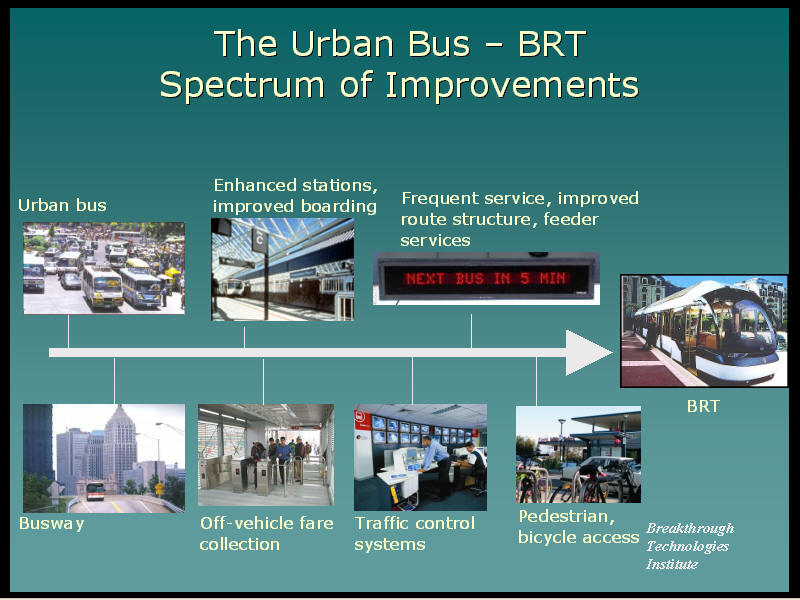Public Interest Transportation Forum - http://www.bettertransport.info/pitf
![]()
![]()
Click here for information from Federal Transit Administration (FTA) on Bus Rapid Transit (BRT), a repackaging and enhancement of express bus service to make it more like rail service, but at the same time offer a speed of deployment over a wider geographic area than is possible with light rail lines.
Some very BRT-like services are available in central Puget Sound, and all three counties of the Sound Transit taxing district are developing new BRT services. Already, Sound Transit's Regional Express bus services have some of the characteristics of BRT. See below.
The FTA executive secretariat for the BRT Action Plan is an organization called WestStart-CALSTART. This is an advanced transportation technologies consortium dedicated to creating and expanding a global advanced transportation technologies industry and its markets through technology development, analysis, and implementation. The consortium's goals are to clean the air, create high-quality jobs, and develop energy efficient transportation. Click here for their comprehensive BRT web site.
Another fine website is from the BRT Policy Center at www.gobrt.org, a project of Breakthrough Technologies Institute. Here is a graphical view from the Center of how BRT evolves:

The work of the BRT Policy Center on the use of High Occupancy Toll (HOT) lanes for express bus right of way is especially interesting. Click here to access in a new window.
Seattle Citizen Don Padelford has been studying and advocating BRT on HOT lanes for many years. Some of his work is posted here.
Transit planner Alan Hoffman,
Founding Principal of The Mission Group in San Diego has many fine educational
presentations focused on BRT at
http://missiong.web.aplus.net/ . One outstanding one is a bus rapid
transit technology seminar he presented on May 23, 2006 titled "Transit and
Urban Mobility: The Role of Bus Rapid Transit in Shaping and Serving Cities and
Regions." He elaborates on the two key BRT modes--"Lite Rail Lite" and "Quickway-based"
systems--and places them both in the context of larger transportation and urban
development strategies. The BRT systems in Curitiba, Bogota, Brisbane, and San
Diego are used as examples.
A 9 megabyte copy of the graphics are available from his web site. His
conclusion is that "bus rapid transit allows you to do things you just can't do
with light rail."
Bus Rapid Transit is beginning to be seen in
Central Puget Sound Region.
For example, the first actions taken by Sound Transit following voter approval in 1996 were the improvement of express bus service and associated park & ride facilities. ST Express began servicBellevue, Tacoma and Everett with communities throughout the region. There are now approximately 20 routes in service. The emphasis is on service between communities, so the buses use freeway HOV lanes and do not stop except in major activity centers and transfer points. The official web site for ST Express has maps, schedules, and fare information. ST Express is a form of Bus Rapid Transit, although Sound Transit does not characterize it as such.
As of Spring 2006, Sound Transit has developed its own conceptions of BRT to make sure that this mode is viewed as inferior to light rail in capacity and speed, and thus is perceived as a precursor service to light rail. Sound Transit has developed a series of light rail and BRT alternatives for high capacity transit service between Seattle and the Eastside suburbs. The Sound Transit analysis of the alternatives, in PDF here, has been sharply attacked by transit activists for its inaccurate portrayal of cost and performance, as of late May 2005.
Existing express bus service in the region has some of the characteristics of BRT. Click here for access to the official web sites of existing bus transit systems in the central Puget Sound region: King County Metro Transit, Pierce Transit, Kitsap Transit, Community Transit, and Everett City Transit. (Kitsap Transit operates outside of the RTA service area.) The Downtown Seattle Transit Tunnel (the Bus Tunnel) is considered a BRT right of way by the Federal Transit Administration.
On March 12, 2001 Sound Transit held a public forum on Bus Rapid Transit where evidence was presented that advanced bus service packaged as Bus Rapid Transit (BRT) is as attractive to customers as rail transit. The key evidence for this attractiveness from two academic studies was summarized by Sam Zimmerman of DMJM+Harris as follows: "In competition with driving, travelers perceive attributes of high quality bus and rail transit as equivalent."
A September 2001 report from U.S. General Accounting Office examines Bus Rapid Transit and finds it a promising alternative to light rail. Report available to download at http://www.gao.gov/new.items/d01984.pdf .
In early 2001, former Seattle Metro Transit Director Chuck Collins presented a comprehensive bus improvement plan that would serve as a cost-effective alternative to Central Link Light Rail. The plan is called Ride Free Express.
In late 2001, King County Councilwoman Maggie Fimia published a report from three of the PITF editors on Bus Rapid Transit as an alternative to Central Link Light Rail. This report is available for download as a pdf.
Access to pages from a Transit Capacity Manual (pdf) showing that demonstrated bus line peak capacity exceeds demonstrated light rail line peak capacity across many U.S. cities.
![]()
![]()
Return to the Public Interest Transportation Forum home page.
![]()
Last modified: February 07, 2011